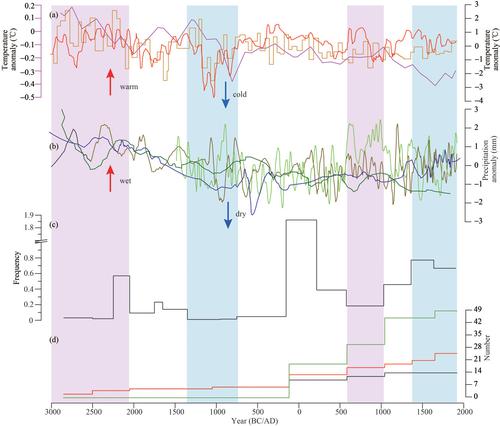当前位置:
X-MOL 学术
›
Acta Geol. Sinica Engl. Ed.
›
论文详情
Our official English website, www.x-mol.net, welcomes your
feedback! (Note: you will need to create a separate account there.)
Climate Change, Geopolitics, and Human Settlements in the Hexi Corridor over the Last 5,000 Years
Acta Geologica Sinica-English Edition ( IF 3.5 ) Pub Date : 2020-06-26 , DOI: 10.1111/1755-6724.14529 Liu YANG 1 , Zhilin SHI 1 , Shanjia ZHANG 1 , Harry F. LEE 2
Acta Geologica Sinica-English Edition ( IF 3.5 ) Pub Date : 2020-06-26 , DOI: 10.1111/1755-6724.14529 Liu YANG 1 , Zhilin SHI 1 , Shanjia ZHANG 1 , Harry F. LEE 2
Affiliation

|
Social responses to climate change over human history have been widely discussed in academia over the last two decades. However, the transformation of the human–environment nexus crossing prehistoric and historic periods and the processes associated with it are not yet clearly understood. In this study, based on published works on radiocarbon dating, archaeobotany, zooarchaeology, and archaeological sites, together with a synthesis of historical documents and high‐resolution paleoclimatic records, we trace the extent to which human settlement patterns in the Hexi Corridor in northwestern China evolved in conjunction with climate change over the last 5,000 years. A total of 129 Neolithic, 126 Bronze Age, and 1,378 historical sites in the Hexi Corridor (n=1,633) were surveyed. Our results show that, in the Late Neolithic and Bronze Age periods (~2800–100 BC), climate change contributed to the transformation of subsistence strategies and the subsequent changes in human settlement patterns in the Hexi Corridor. The warm‐humid climate in ~2800–2000 BC promoted millet agriculture and helped the Majiayao, Banshan, and Machang Cultures to flourish. The cold‐dry climate in ~2000–100 BC resulted in the divergence and transformation of subsistence strategies in the Xichengyi–Qijia–Siba and Shajing–Shanma Cultures and in a shift in their settlement patterns. However, in the historical period (121 BC–AD 1911), human settlement patterns were primarily determined by geopolitics related to the alternating rule of regimes and frequent wars, especially in the Sui–Tang dynasties. We also find that trans‐Eurasian cultural exchange since ~2000 BC improved social resilience to climate change in the Hexi Corridor, mediating the human–environment nexus there. Our findings may provide insights into how human societies reacted to climate change in arid and semi‐arid environments over the long term.
更新日期:2020-06-26











































 京公网安备 11010802027423号
京公网安备 11010802027423号